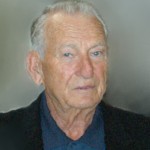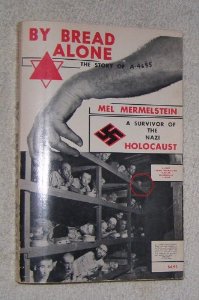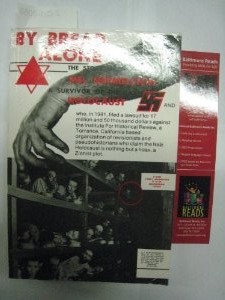Posted on February 24, 2013 at 6:49 am
Elie Wiesel was unknown to Mel Mermelstein in the Buchenwald Camp
By Carolyn Yeager
copyright 2013 Carolyn Yeager
According to our esteemed correspondent Attila Kovacs, his reading of Mel Mermelstein’s survivor story reveals no mention of the famous Elie Wiesel, even though the book first came out in 1979 when Wiesel and his own story was already well-known among the general public.
The first edition [right] was 264 pages, published by Crescent Books. In 1981, a second edition of the book [below right] came out, following Mermelstein’s dispute in 1980 with the Institute for Historical Review (IHR) over his claimed proof that even a single Jew was gassed at Auschwitz.
The second edition of By Bread Alone was published by the “Auschwitz Study Foundation” and retains the same cover design, but with some new text added referring to the author’s successful lawsuit. It is expanded to 290 pages from 264 pages in the first edition – an increase of 26 pages to include the lawsuit story. The new cover texts reads:
who, in 1981, filed a lawsuit for 17 million and 50 thousand dollars against the Institute for Historical Review, a Torrance, California-based organization of revisionists and pseudohistorians who claim the Nazi Holocaust is nothing but a hoax, a Zionist plot.
The only other change is that the price that was printed in red on the lower tab on the right side has been removed.
How well-known was Elie Wiesel in 1979?
It was 1978 when Wiesel was appointed by President Jimmy Carter as chairman for the Presidential Commission on the Holocaust (later renamed US Holocaust Memorial Council), indicating that he was at that time a recognized ‘authority’ on all things ‘holocaust.’ In fact, Wiesel claims that it was he who coined the term ‘Holocaust’ for the Jewish ‘Shoah,’ even though he doesn’t like the term. Typical Wieselspeak. That’s a term I just coined!
In 1979, Wiesel’s 15th book was published, the title being A Jew Today, a collection of essays, letters and diary entries weaving together all the periods of his life up until then. To put out a book such as that, one has to have a substantial following. Fifteen books by 1979! It is unimaginable that a Hungarian ‘survivor’ such as Mel Mermelstein would not be familiar with Elie Wiesel.
Attila Kovacs tells us what he discovered reading Mel’s book
In his own words he writes:
First, I must admit that reading the book the second time was somewhat of a struggle as there were so many confusing items, too many irrelevant, random photos, and the quality of the story left a lot to be desired from a strictly literary sense. The author jumps around as to his own identity as a Jew, (he is) a Hungarian Jew, a Czechoslovak, a Karpatho-Rus, and a Czech – to the point that I was confused as to what his main claim was as to nationality, mother tongue, ethnic origin.
But as to his being Hungarian, there is little doubt:
Lajos, his brother, Magda, his sister, and friends Joncsi (probably just a typo as Jancsi is a common Hungarian name), Pista, and Moric are all Hungarian names; in this regard, Etu may be Eti. His labor camp documents all say Ungarn, which is Hungarian in German. In addition, he refers to his hometown as Munkacs, which is Hungarian. It is telling in that the author did not use the Czech or Slovak spelling of Mukacevo or Mukaceve or the Ukrainian/Russian name of Mukacheve. Then on p. 17, he calls out to his father as ‘apu’ which is Hungarian for father.
As such, one has to assume that his mother tongue used in the home and in Munkacs and in the camps with other Hungarian Jews is Hungarian. In “Youtube” videos showing life in Munkacs in the 1930′s – the Jewish schoolchildren singing, a large town center wedding, and street conversations of the Jews are practically all in Hungarian.
Since in Elie Wiesel’s own “Youtube” video of his return visit to his hometown of Sighet he is speaking Hungarian with the old town folk, it seems that Moric (Mel) and Elie would have a lot in common and would converse in Hungarian at Buchenwald.
Yes, you would certainly think so. But one can get the impression that Wiesel is unable to converse comfortably in Hungarian because he often refuses to speak it in public. As he did with Nikolas Grüner in Stockholm. However, you would know this better than I.
The only reference in the book to Elie Wiesel is on page x, prior to the Forward, where it [quotes] a statement made by Professor Elie Wiesel of Boston University. So apparently the author knew of Professor Wiesel at the time he wrote the book.
There is a mention on p. 195 of “walked from one barracks (at Buchenwald) to another until I found Elijah, a frail bent youngster from Sighet.” There were a couple of other name mentions of Elijah, but nothing other than the name. So if this was indeed Elie Wiesel, one would think that the author would brag about this important Holocaust celebrity or their common roots, or their common experiences in the Munkacs-Sighet Jewish community, or about what they did together in Buchenwald especially with respect to the famous Buchenwald Liberation photo.
Yes, indeed. “Elijah” cannot be Elie Wiesel. For one thing, Wiesel was not frail and bent. The man he purports to be himself in the Famous Buchenwald Lie-beration Photo on Mel’s book cover is not frail looking at all. (Of course, I should hardly mention that since it’s been proven not to be Elie Wiesel.) But also, photos of Elie Wiesel in France from July-Sept. 1945 onward show a sturdy, vigorous, smiling lad with a head full of longish black hair. Plus Elijah was not an uncommon name amongst the Orthodox Hasidic sect of Hungarian Jews, and some from this sect were in the camp.
 Does Mermelstein give many dates in his book? According to this source, he arrived at Buchenwald on or about February 10, 1945, he remained in the camp until it was liberated by American troops on April 11, 1945. That is only a 2-month stay. He was born on Sept. 25, 1926, making him exactly 2-years older than Elie Wiesel. He is now around 85. (recent photo of Mermelstein at left)
Does Mermelstein give many dates in his book? According to this source, he arrived at Buchenwald on or about February 10, 1945, he remained in the camp until it was liberated by American troops on April 11, 1945. That is only a 2-month stay. He was born on Sept. 25, 1926, making him exactly 2-years older than Elie Wiesel. He is now around 85. (recent photo of Mermelstein at left)
The same source also states this important information: In none of the numerous newspaper interviews he gave prior to 1980 (that we were able to discover) did he make any mention of seeing anyone go into any gas chamber [at Auschwitz-Birkenau]. Similarly, Mermelstein makes no mention of seeing his mother and sisters enter any building or “gas chamber” in the first, 1979 edition of his detailed memoir, By Bread Alone (written before the reward offer).
By the way, the liberation photo is only mentioned on p. 223. Less than one solitary page devoted to the cover picture which shows the author in the upper, most distant spot in the photo. Oh, well.
This confirms my theory in the previous article that 1) it did not mean as much to be in this picture prior to the identification of Elie Wiesel in it, and 2) Wiesel was not identified in it until 1983, after both editions of Mermelstein’s book had been issued. Even though Mel used the picture on the cover of both editions (without the standing man), it was probably only to prove that he was there and that it was as bad as he said it was. That the photo without the standing man was used on both editions also proves that it was not a mistake or an oversight; if it were it would have been corrected on the 2nd edition (unless, of course, this was a real low-budget operation and making a change on the cover was cost-prohibitive).
A can of worms has been opened here, there is no doubt about it.
What is most interesting is the disclaimer on page iv of the book, which I quote: “About the Characters in This Book – Though the characters in this story are real, I felt their names had to be changed to protect their privacy. I have not consulted with any of the survivors mentioned here, because I know how some might feel if the story of their part in the Holocaust were brought to them once again to be dealt with.”
Wow! Go figure then: why he would use his own name rather than a fictitious name; not want to fact check with known survivors; be concerned about privacy when others had written their own books (cannot recall how many in the photo have written their own books about Buchenwald and/or Auschwitz, etc.)
I don’t know of any book by anyone who was actually there; a lot of fraud is involved with this photo. But nevertheless, he certainly would not have changed the name of Elie Wiesel, since this man had already made his own experiences at Auschwitz and Buchenwald very well known. Mel could not speak of Elie Wiesel in Buchenwald because he never met or saw such a person there! Just like Nikolas (Myklos, Michael) Grüner, Mel Mermelstein was actually in Buchenwald (although he lies about what happened to his family and others) and thus his silence on Elie Wiesel completely refutes the testimony of Wiesel.
Nikolas Grüner and Morik Mermelstein are in the Buchenwald Lie-beration photo, but the fraud known as Elie Wiesel is not.
The author, Mr. Moric Mermelstein, does NOT mention or say anything about who (names or descriptions) was with him in the photo of barracks 56 on April 16th around noon.
Query: Whether or not an author in an iconic photo of yesteryear would not mention that in the old grainy middle school team photo the fact that Michael Jordan was in fact the scrawny, short but smiling kid at the end of row two sandwiched between the team water boy and a forgotten assistant coach?
Yes, Attila is so right. If such an “iconic” person were with you during a period of your life that you are writing about, and even in the same room — and a photograph existed that showed it — well, anyone would certainly mention it. There can be no doubt that Mr. Mermelstein’s book has given us more proof that Elie Wiesel is not in the Buchenwald picture. I don’t suppose Mel will be too pleased with helping our revisionist cause, but so he has. Thanks Mel! You won a battle, but you’re losing the war.
Categories Featured | Tags:
Leave a Reply
By submitting a comment here you grant Elie Wiesel Cons the World a perpetual license to reproduce your words and name/web site in attribution. Inappropriate or irrelevant comments will be removed at an admin's discretion.




7 Comments to Elie Wiesel was unknown to Mel Mermelstein in the Buchenwald Camp
by Litigator
On February 24, 2013 at 2:45 pm
Mermelstein never “won a battle” over the IHR reward for proof of the gassings since he did not provide the proof required. The judge however found in his favour by deceitfully declaring, through the improper exercise of Judicial Notice, that the gassings took place and accepting his own personal endorsement of the fraud as “proof” – a finding that would have been impossible before an honest, informed Judge . Succeeding through cheating is not really “winning”, a reality that is well known in the sports world and most elsewhere.
by Carolyn
On February 25, 2013 at 5:44 am
You are technically right, Litigator, and thank you for this clarification, but Mermelstein thinks he won. He did get the money.
The thought that comes to my mind about the judge and all … is that if IHR had done the research they might have discovered that California did have that “Judicial Notice” on its books. Then they wouldn’t have been so cocky and lost all that money. Mermelstein, the Jew, had better legal sense and did his homework. Why does it always work that way? We need to work at better understanding of our enemy, rather than relying on “honor.”
by Ministry Of Truth
On February 26, 2013 at 1:01 am
Too bad the transcripts of Mel Mermelstein’s testimonies are not accessible on the USHHM site. Neither are those of Elie Wiesel.
I’d be curious to read the testimony of beautiful* Gina Sack and her interactions with Elie Wiesel.
*she made a facial paste with her mother and cousin to make herself look less attractive in an effort to discourage men from sexually violating her.
by Attila Kovacs
On March 16, 2013 at 10:31 am
I just wanted to let you know how much I appreciate the scholarly analysis and discussion on this site and some of the related sites that are shown as links. For many years, I have been a hard to convince type of guy, always asking questions and demanding clear proof. While that may be an ideal world, my suspicious nature always took over. Well researched and well footnoted papers always more convincing than personal, subjective attacks. As such, I have a general question that has been troubling me for sometime: if there was no final solution (vs. total solution), if there was no gassing at the labor camps, if there exists no smoking gun document, then how is it possible that hundreds of thousands Jews are making up this stuff in order to look good, financially extort money from the Germans, Swiss, etc. It would seem to me that some would come forward and admit to all this being a lie or a misrepresentation, or deception of unprecedented proportions? BTW I found the articles on the Wiesel vs. Simon Wiesenthal, the gassing vehicles, and the Miklos Gruner vs. Elie Wiesel stolen identity very informative. If an ordinary person does not come away from all of this with a healthy dose of skepticism, then I am afraid, they have drunk too much of the Kool-aide. Keep up the good work.
by Carolyn
On March 17, 2013 at 8:39 am
To Attila – thanks for your enquiry.
You are doing what most people do when they are faced with “the Big Lie.” They assume thousands of people had to be involved, all complicit and keeping the secret. It’s not that way. “Hundreds of thousands” of Jews did not make stuff up in the beginning. Only a few needed to do so; the rest copied them. Rumors were encouraged from at least 1943. Remember, the camps were full of Partisans-Resistance Fighters, from the West and from the East. These were all Leftists and Communists, many politically sophisticated and knowledgeable in the use of political tactics. They organized in the camps. Unless the camp commanders executed them or kept them further confined in prison cells, there was no way to stop it in such close quarters. Of course, it was underground, not out in the open. Political allegiance doesn’t end when one is captured. So the political Jews and Communists did their work in creating false atrocity stories and rumors on the inside, while International Jewry and International Communism did it on the outside. Those on the outside said they were receiving news from the inside about gassings, executions, beatings, starvation and overwork, etc, etc. and these got newspaper publicity. Jewish-Communist Hollywood was also doing it’s part.
So all these Jews you point to were getting their information in this way, and after “liberation” they were in DP camps and interviewed, being encouraged by the military occupation to make their stories as gory as possible. They copied from each other and from what they were hearing. The best ones were selected to testify at the war criminal tribunals that were being set up at Nuremburg. This was where the Allied governments got into it big time to bolster their victory and their right to pillage everything they could from Germany and her people. Ordinary persons are easily convinced they are telling the truth when everyone around agrees, praises them and rewards them for their “stories.” And if it happened to someone else (who is also witnessing to it) it could have happened to you, too, even though it didn’t actually. But you might as well benefit from it, yes? Jews who know the Germans really did detain and deport their people, and also make them perform labor without pay (awful in itself!!) don’t suddenly decide to tell the truth about such an enemy people. What we’ve found is that they suddenly decide to make up a story of their own, even after 60 years!
by Attila Kovacs
On March 17, 2013 at 12:57 pm
Thank you for the quick reply. I will mull it over as I thought about another analogy.
Some 400,000 people attended Woodstock, but some 3 million today claim that they were there in fact. Some even get the decade mixed up, the bands who played, etc. I called that the Woodstock effect.
Trackbacks